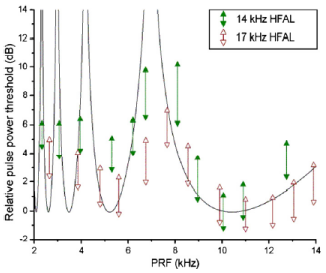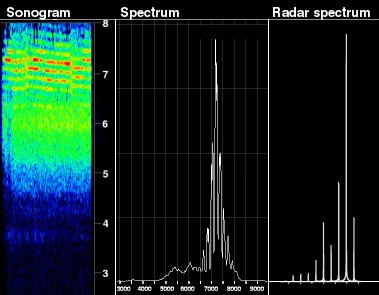 old the presses! The New York Times has finally
figured
out what everyone else has known for over a year now: that the sonic attacks
on the Cuban embassy could have resulted from microwaves. They're saying it's something
they call the Frey effect, where microwaves directly stimulate the auditory cortex.
old the presses! The New York Times has finally
figured
out what everyone else has known for over a year now: that the sonic attacks
on the Cuban embassy could have resulted from microwaves. They're saying it's something
they call the Frey effect, where microwaves directly stimulate the auditory cortex.
In this article I'll discuss some of the myths about the microwave acoustic effect, and I'll address the question: could ordinary radar waveforms produce the sounds that have been reported?
The Frey Effect
Searching for the phrase “Frey Effect” is fruitless, suggesting that no one but the Grey Lady actually calls it that, but way back in the 1960s a guy named A.H. Frey did publish several articles showing that low-intensity UHF energy, aka microwaves, can evoke electrical responses in the brain. He argued two main points: that microwaves can induce cataracts[1] and that hearing of electromagnetic energy occurs by thermoacoustic expansion in the cochlea[2]. He credits a personal communication from R.M. White for this idea.
I could find no credible papers that claimed that microwaves can directly stimulate the auditory cortex. Microwaves can, of course, be highly destructive to brain tissue, but the most widely accepted theory for how we can hear them is the thermoelastic theory, which was proposed way back in 1974 by Foster and Finch [5]. The state of the science was reviewed by James C. Lin [3], who did a vast amount of pioneering theoretical work on this phenomenon. Experimental work proved that it involves the cochlea and not direct electrical transduction. According to some Israeli researchers[4], who extended Lin's mathematical theory, as little as a millionth of a degree C is enough. The Israelis looked at the phenomenon that interests us today: pulse trains.
Pulse trains and Barker codes

N.M. Yitzhak's graph showing acoustic threshold vs pulse repetition frequency. Higher threshold = less sensitivity
Many, if not most, modern military radars use some variation of a continuous sweep, or chirp, instead of a fixed-frequency pulse train, because chirps use less power and they're harder for the enemy to detect. But in the olden days, radar used a series of pulses at a fixed frequency, called pulse trains. They are described by three simple parameters: the power, the repetition frequency or PRF, and the pulse width.
Using Lin's equations, Yitzhak et al.[4] found that the hearing threshold of rectangular pulses was strongly dependent on the pulse repetition frequency. In this simulation, 800 MHz radio waves at a 20 μs pulse width had a threshold maximum at a PRF of around 7 kHz, as shown in this figure. They say it matches the data from Tyazhelov, who beamed 500 watt microwaves into the parietal area of two human volunteers.
Tyazhelov et al. found that the perceived sound got lower in pitch when the pulse width increased toward 100 microseconds, and that dunking one's head in water reduced the loudness of the RF signal[6] . The idea was not to create a weapon, but to understand it and maybe, it was hoped, use the effect for thermoacoustic tomography.

Barker-coded pulse train
The problem with fixed-frequency pulse trains is that they're very easy to detect, which means they're easy to jam. One way of thwarting this is by using phase coding, in which the phase of some of the pulses is adjusted so as to create an inverted pulse. For example, your pulse train might look like this: [+1 +1 +1 −1 −1 +1 −1 ]. If the adversary didn't know this sequence, they'd have great difficulty in jamming your radar, because you could reject any radar returns that didn't have this code.
The Cuban Embassy microwave attacks
How does this relate to Cuba? It turns out that phase-coded waveforms, like any other kind of modulation, push some of the rf energy out into surrounding frequencies. We all know how, in an AM radio, for instance, a 5 kHz wide audio signal turns a sine wave into a band of frequencies 10 kHz wide. Even a simple Barker coding can produce a spectrum similar to the one that was supposedly recorded in Cuba, as shown in the figure below.

Left: Sonogram of sound purportedly recorded at US embassy in Cuba showing how the sound changes over time. Note how the frequency decreases over time. RF emissions from many commodity devices, like microwave ovens, show a similar effect. Middle: Spectrum of sound at US embassy at a single time point. See here for a discussion of how this sound might have been recorded. Right: Simulated spectrum of pulse-coded radar.
Well, trying to match the waveforms exactly would be a lot like doing work, so I didn't spend much time on this; I just used a short code, but it pops right out when you do a Fourier transform. Undoubtedly, the US military would never use a scheme like this, for a number of reasons. More sophisticated codes are available, and often the goal is to be undetectable, never mind to be picked up by ear. So a real coded radar signal from a modern system would be much more complex, it would have more peaks, and the wavelength maxima would shift over time.
Of course, the resemblance might be coincidental, and there's no guarantee the State Department would release anything that could be turned around and used against them. But there's an even more likely possibility: the Cubans are known to use very similar acoustic noises to torture political prisoners.
Couldn't the Cubans just beam sonic noises into an embassy? That would be difficult: the sound would bounce off the walls, and pedestrians walking outside would hear it. And they couldn't place a device inside, because it would be found. But there's no reason why they couldn't modulate a beam, maybe even a crude one generated from a microwave oven, with the same audio waveform that they use against prisoners. Microwaves would pass right through the walls, unless the building was shielded. The people inside would have no idea where the sound was coming from, and would be unable to protect themselves.
In fact, putting one of those devices in a van or small truck is such an obvious thing to do that I'd be utterly shocked if that's not what they're doing.
Update (sep 12 2018) How much power would the Cubans need? That's easy to calculate. A back of the envelope calculation shows that if a microwave oven raises something by 100° six inches away, a beam the same size could raise water by 1e−6° 5000 feet away. If it was 100 yards away, and properly modulated, it would be 24 decibels above the hearing threshold. Of course, with a wavelength of 12.2 cm (2.45 GHz) you'd need a reasonably big antenna to produce such a narrow beam. If they were smart, they'd use a shorter wavelength. Of course, if they were smart, they wouldn't be doing this at all.
References
(Trigger Warning: these articles are not available online).
1. J Microw Power Electromagn Energy. 1985;20(1):53–55. Data analysis reveals significant microwave-induced eye damage in humans. Frey AH. https://www.ncbi.nlm.nih.gov/pubmed/3847507
2 Science. 1979 Oct 12;206(4415):232–234. Holographic assessment of a hypothesized microwave hearing mechanism. Frey AH, Coren E. https://www.ncbi.nlm.nih.gov/pubmed/482939
3. Lin JC Wang Z Health Phys 2007 jun 92(6) 621–628 Hearing of microwave pulses by humans and animals: effects, mechanism, and thresholds https://www.ncbi.nlm.nih.gov/pubmed/17495664
4. Yitzhak NM Ruppin R Hareuveny R Phys Med Biol 2009, 54(13) 4037–4049 generalized model of the microwave auditory effect https://www.ncbi.nlm.nih.gov/pubmed/19502702
5 Foster KR, Finch ED (1974). Microwave hearing: evidence for thermoacoustic auditory stimulation by pulsed microwaves. Science 185 256–258
6 Tyazhelov VV, Tigranian RE, Khizhniak EO, Akoev IG (1979). Some peculiarities of auditory sensations evoked by pulsed microwave fields. Radio Science 14, 259–263
sep 03 2018, 5:22 am; minor editing sep 05, 2018 4:35 am. sonogram added sep 09, 2018 5:30 am. last edited sep 12 2018, 4:40 am
